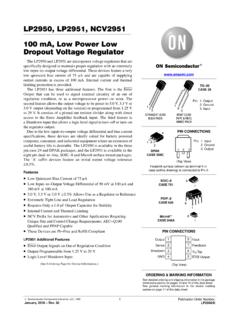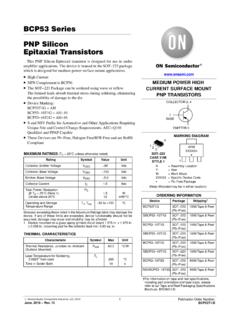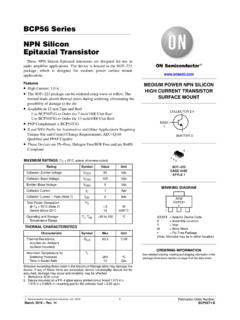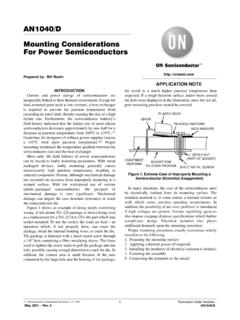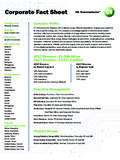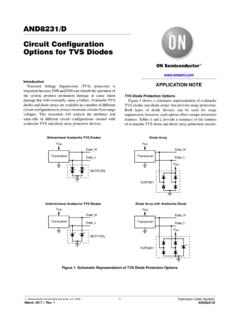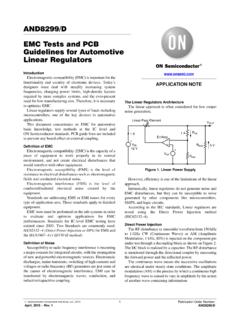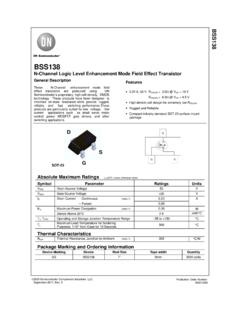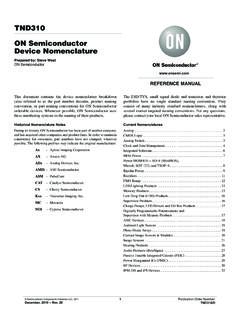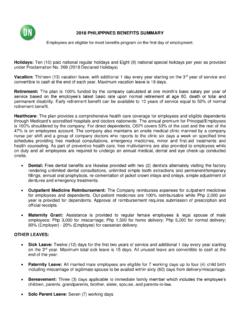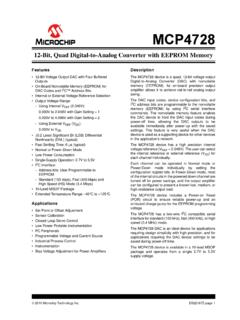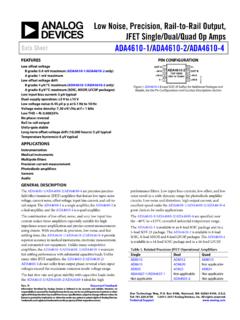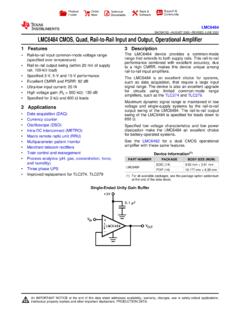Transcription of LMV321 - Single, Dual, Quad Low-Voltage, Rail-to-Rail ...
1 Semiconductor Components Industries, LLC, 2015 January, 2021 Rev. 161 Publication Order Number: LMV321 /DSingle, Dual, QuadLow- voltage , Rail-to-RailOperational AmplifiersLMV321, NCV321, LMV358,LMV324 The LMV321 , LMV321I, NCV321, LMV358/LMV358I andLMV324 are CMOS single, dual, and quad low voltage operationalamplifiers with rail to rail output swing. These amplifiers are acost effective solution for applications where low power consumptionand space saving packages are critical. Specification tables areprovided for operation from power supply voltages at V and 5 to Rail operation provides improved signal to noisepreformance. Ultra low quiescent current makes this series ofamplifiers ideal for portable, battery operated equipment.
2 Thecommon mode input range includes ground making the device usefulfor low side current shunt measurements. The ultra small packagesallow for placement on the PCB in close proximity to the signal sourcethereby reducing noise Operation from V to V Single Sided Power Supply LMV321 Single Available in Ultra Small 5 Pin SC70 Package No Output Crossover Distortion Rail to Rail Output Low Quiescent Current: LMV358 Dual 220 mA, Max per Channel No Output Phase Reversal from Overdriven Input NCV Prefix for Automotive and Other Applications RequiringUnique Site and Control Change Requirements; AEC Q100 Qualified and PPAP Capable These Devices are Pb Free, Halogen Free/BFR Free and are RoHSCompliantTypical Applications Notebook Computers and PDA s Portable Battery Operated Instruments Active FiltersSC 70 CASE 419 ASee detailed ordering and shipping information in the packagedimensions section on page 12 of this data AND MARKING INFORMATIONM icro8 CASE 846 AUDFN8 CASE 517 AJSOIC 14 CASE 751 ATSSOP 14 CASE 948G111 SOIC 8 CASE 7511811815 TSOP 5 CASE , NCV321, LMV358, DIAGRAMSAAC MGGAAC= Specific Device CodeM= Date CodeG= Pb Free PackagePIN CONNECTIONS(Top View)
3 SC70 5/TSOP 5+INV INV+OUTPUT +21354 LMV324 ALYW114 LMV324 = Specific Device CodeA= Assembly LocationL= Wafer LotY= YearW= Work WeekG= Pb Free PackageV358= Specific Device CodeA= Assembly LocationY= YearW= Work WeekG= Pb Free Package(Note: Microdot may be in either location)V358 AYWGG18 LMV324 AWLYWWG114 LMV324 = Specific Device CodeA= Assembly LocationWL= Wafer LotY= YearWW= Work WeekG= Pb Free PackageAC = Specific Device CodeM= Date CodeG= Pb Free PackageOUT A1234 ++ 8765IN A IN A+V V+OUT BIN B IN B+ABUDFN8/Micro8/SOIC 81234567141312111098 +A+ D ++ BCOUT AIN A IN A+V+IN B+IN B OUT BOUT DIN D IN D+V IN C+IN C OUT CSOIC 141234567141312111098 +A+ D ++ BCOUT AIN A IN A+V+IN B+IN B OUT BOUT DIN D IN D+V IN C+IN C OUT CTSSOP 14(Top View)(Top View)(Top View)
4 V358 ALYW G18V358= Specific Device CodeA= Assembly LocationL= Wafer LotY= YearW= Work WeekG= Pb Free PackageSC 70 UDFN8 SOIC 14 TSSOP 14 Micro8 SOIC 8AC MG153 ACAYWGG3AC = Specific Device CodeA= Assembly LocationY= YearW= Work WeekG= Pb Free PackageTSOP 5(Note: Microdot may be in either location)(Note: Microdot may be in either location) LMV321 , NCV321, LMV358, RATINGSS ymbolRatingValueUnitVSSupply voltage (Operating Range VS = V to V) Differential voltage $Supply VoltageVVICRI nput Common Mode voltage Range to (V+) + Maximum Input Current10mAtSoOutput Short Circuit (Note 1)Continuous TJMaximum Junction Temperature150 CTAO perating Ambient Temperature RangeLMV321, LMV358, LMV324 LMV321I, LMV358 INCV321 (Note 2) 40 to 85 40 to 125 40 to 125 C C CqJAThermal Resistance.
5 C/WSC 70280 Micro8238 TSOP 5333 UDFN8 ( mm x mm x mm)350 SOIC 8212 SOIC 14156 TSSOP 14190 TstgStorage Temperature 65 to 150 CMounting Temperature (Infrared or Convection 20 sec)260 CVESDESD Tolerance (Note 3) LMV321 , LMV321I, NCV321 Machine ModelHuman Body ModelLMV358/358I/324 Machine ModelHuman Body Mode10010001002000 VStresses exceeding those listed in the Maximum Ratings table may damage the device. If any of these limits are exceeded, device functional-ity should not be assumed, damage may occur and reliability may be Continuous short circuit operation to ground at elevated ambient temperature can result in exceeding the maximum allowed junctiontemperature of 150 C. Output currents in excess of 45 mA over long term may adversely affect reliability.
6 Shorting output to either V+or V will adversely affect NCV prefix is qualified for automotive Human Body Model, applicable std. MIL STD 883, Method Model, applicable std. JESD22 A115 A (ESD MM std. of JEDEC)Field Induced Charge Device Model, applicable std. JESD22 C101 C (ESD FICDM std. of JEDEC). LMV321 , NCV321, LMV358, V DC ELECTRICAL CHARACTERISTICS (Unless otherwise specified, all limits are guaranteed for TA = 25 C, V+ = V, RL = 1 MW, V = 0 V, VO = V+/2)ParameterSymbolConditionMinTypMaxUn itInput Offset VoltageVIOTA = TLow to THigh (Note 4) offset voltage Average DriftICVOSTA = TLow to THigh (Note 4)5mV/ CInput Bias CurrentIBTA = TLow to THigh (Note 4) <1nAInput Offset CurrentIIOTA = TLow to THigh (Note 4) <1nACommon Mode Rejection RatioCMRR0 V v VCM v V 5063dBPower Supply Rejection V v V+ v 5 V,VO = 1 V5060dBInput Common Mode voltage RangeVCMFor CMRR w 50 dB0 to to SwingVOHRL = 10 kW to VVCC 100 VCC 10mVVOLRL = 10 kW to V (Note 5)60180mVSupply CurrentLMV321, NCV321 LMV358/LMV358I (Both Amplifiers)
7 LMV324 (4 Amplifiers) V AC ELECTRICAL CHARACTERISTICS (Unless otherwise specified, all limits are guaranteed for TA = 25 C, V+ = V, RL = 1 MW, V = 0 V, VO = V+/2)ParameterSymbolConditionMinTypMaxUn itGain Bandwidth ProductGBWPCL = 200 pF1 MHzPhase MarginQm60 Gain MarginGm10dBInput Referred voltage Noiseenf = 50 kHz50nV/ HzProduct parametric performance is indicated in the Electrical Characteristics for the listed test conditions, unless otherwise noted. Productperformance may not be indicated by the Electrical Characteristics if operated under different For LMV321 , LMV358, LMV324: TA = 40 C to +85 CFor LMV321I, LMV358I, NCV321: TA = 40 C to +125 Guaranteed by design and/or , NCV321, LMV358, V DC ELECTRICAL CHARACTERISTICS (Unless otherwise specified, all limits are guaranteed for TA = 25 C, V+ = V, RL = 1 MW, V = 0 V, VO = V+/2)ParameterSymbolConditionMinTypMaxUn itInput Offset VoltageVIOTA = TLow to THigh (Note 6) offset voltage Average DriftTCVIOTA = TLow to THigh (Note 6)5mV/ CInput Bias Current (Note 7)IBTA = TLow to THigh (Note 6) < 1nAInput Offset Current (Note 7)IIOTA = TLow to THigh (Note 6)< 1nACommon Mode Rejection RatioCMRR0 V v VCM v 4 V 5065dBPower Supply Rejection V v V+ v 5 V,VO = 1 V, VCM = 1 V5060dBInput Common Mode voltage RangeVCMFor CMRR w 50 dB0 to 4 to Signal voltage Gain (Note 7)AVRL = 2 kW15100V/mVTA = TLow to THigh (Note 6)
8 10 Output SwingVOHRL = 2 kW to VTA = TLow to THigh (Note 6)VCC 300 VCC 400 VCC 40mVVOLRL = 2 kW to V (Note 7)TA = TLow to THigh (Note 6)120300400mVVOHRL = 10 kW to V (Note 7)TA = TLow to THigh (Note 6)VCC 100 VCC 200mVVOLRL = 10 kW to VTA = TLow to THigh (Note 6)65180280mVOutput Short Circuit CurrentIOSourcing = VO = 0 V (Note 7)Sinking = VO = 5 V (Note 7)101060160mASupply CurrentICCLMV321TA = TLow to THigh (Note 6)130250350mANCV321TA = TLow to THigh (Note 6)130250350 LMV358/358I Both AmplifiersTA = TLow to THigh (Note 6)210440615 LMV324 All Four AmplifiersTA = TLow to THigh (Note 6) V AC ELECTRICAL CHARACTERISTICS (Unless otherwise specified, all limits are guaranteed for TA = 25 C, V+ = V, RL = 1 MW, V = 0 V, VO = V+/2)ParameterSymbolConditionMinTypMaxUn itSlew RateSR1V/msGain Bandwidth ProductGBWPCL = 200 pF1 MHzPhase MarginQm60 Gain MarginGm10dBInput Referred voltage Noiseenf = 50 kHz50nV/ HzProduct parametric performance is indicated in the Electrical Characteristics for the listed test conditions, unless otherwise noted.
9 Productperformance may not be indicated by the Electrical Characteristics if operated under different For LMV321 , LMV358, LMV324: TA = 40 C to +85 CFor LMV321I, LMV358I, NCV321: TA = 40 C to +125 Guaranteed by design and/or , NCV321, LMV358, CHARACTERISTICS(TA = 25 C and VS = 5 V unless otherwise specified)Figure 1. Open Loop Frequency Response(RL = 2 kW, TA = 255C, VS = 5 V)Figure 2. Open Loop Phase Margin(RL = 2 kW, TA = 255C, VS = 5 V)FREQUENCY (Hz)PHASE MARGIN ( )1009080706050403020100101001k10k100kFig ure 3. CMRR vs. Frequency(RL = 5 kW, VS = 5 V)FREQUENCY (Hz)CMRR (dB)3035404550556065707580 4. CMRR vs. Input Common ModeVoltageINPUT COMMON MODE voltage (V)CMRR (dB)304050607080 1012345 Figure 5. CMRR vs. Input Common ModeVoltageINPUT COMMON MODE voltage (V)CMRR (dB)10090807060504030201001k10k100k1M10 MFigure 6.
10 PSRR vs. Frequency(RL = 5 kW, VS = V, +PSRR)FREQUENCY (Hz)PSRR (dB)FREQUENCY (Hz)GAIN (dB)VS = 5 Vf = 10 kHzVS = Vf = 10 kHz1030507090110130150170 20020406080100120 Same Gain $ dB (Typ)1k10k100k1M10M100101k10k100k1M10M10 010 LMV321 , NCV321, LMV358, CHARACTERISTICS(TA = 25 C and VS = 5 V unless otherwise specified)90807060504030201001k10k100k1M 10 MFigure 7. PSRR vs. Frequency(RL = 5 kW, VS = V, PSRR)FREQUENCY (Hz)PSRR (dB)10090807060504030201001k10k100k1M10 MFigure 8. PSRR vs. Frequency(RL = 5 kW, VS = 5 V, +PSRR)FREQUENCY (Hz)PSRR (dB)10090807060504030201001k10k100k1M10 MFigure 9. PSRR vs. Frequency(RL = 5 kW, VS = 5 V, PSRR)FREQUENCY (Hz)PSRR (dB) 10. VOS vs CMRVCM (V)VOS (mV)VS = 11. VOS vs CMRVCM (V)VOS (mV)VS = 12. Supply Current vs.
